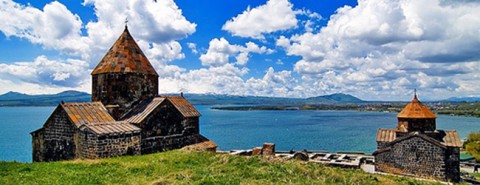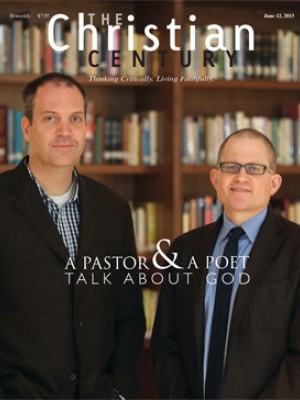Armenia’s survivors
In northeastern Turkey stand the ruins of what was once one of the world’s largest and most imposing cities. In the Middle Ages, Ani was the “City of 1,001 Churches,” the capital of Armenia’s mighty Bagratuni dynasty which held off both the Christian Byzantine Empire and the Arab Caliphate.
The Bagratid kingdom is long gone, like Ani itself, but Armenians survive. Although Armenia’s Christian past is little known in the West, it is an awe-inspiring tale of endurance in a profoundly hostile political and religious setting. So devastating have been some of these events that outsiders have repeatedly been tempted to write the obituary of Armenia, yet people, nation and church continue.
Read our latest issue or browse back issues.
Armenia today is a small nation of some 3.3 million people in a territory barely a quarter the size of Pennsylvania. Officially, it is also a new country, independent only since 1991. Such curt facts conceal a deep antiquity.
Apart from Rome, how many other capital cities can plausibly claim a foundation date in the eighth century BC, as does Armenia’s Yerevan? An already ancient kingdom accepted Christianity around 301, making it probably the world’s oldest Christian state (Ethiopia challenges that title). The Bible was translated into Armenian before the time of Chalcedon, in 451.
In space as well as time, Armenia’s present small scale belies a much larger ancient reality. In the Middle Ages, different versions of the Armenian Empire sprawled over much of what is now eastern Turkey, penetrating into Iran.
For a thousand years, Armenia was home to a thriving Christian culture. It included the spiritual center of Etchmiadzin, “the place where the Only-Begotten descended,” where the cathedral claims a foundation date of 303. Haghpat and Sanahin are the stars among the great monastic complexes.
Besides its physical monuments, medieval Armenia had a flourishing tradition of scholarship and visual art. The 12th and 13th centuries witnessed an artistic and scholarly resurgence—led by the Katholikos Nerses IV and the polymath monk Mkhitar Gosh—equal to anything in medieval Europe.
Beginning in the 13th century, however, Armenia was overwhelmed by repeated disasters. Ani never recovered from the Mongol sack of 1236. In 1375, the Egyptian Mamluks ended the last independent Armenian kingdom and demolished the beloved ecclesiastical capital of Sis. Armenians recall the following 200 years as a dark age, the beginning of their great diaspora.
The nature of Muslim rule varied over time, but persecution could at times be horrendous. Even under tolerant regimes, Armenians suffered from their strategic position on the borders of the rival Ottoman and Persian empires, whose epic military campaigns repeatedly laid waste the country. Yerevan changed hands 14 times in 250 years. The Russians later joined the struggles in the region.
But despite the calamities, Armenians survived in ways that recall the persistent refusal of Jews to vanish from history. Wiser Muslim rulers valued their Armenian subjects for their acumen and their international connections.
In 1604, Persia’s ruler Shah Abbas established the Armenian mercantile settlement at New Julfa, which rapidly became extremely wealthy and globally connected. Under Persian rule, New Julfa’s Christians traded throughout Europe, Russia and the Middle East and into China, India and the Philippines. Armenians were likewise the merchants and traders of the Ottoman Empire. By 1900, they had a strong presence in the Ottoman cities, constituting a sixth of the population in Constantinople itself.
And then once again, the world seemed to end. In 1915, Armenians suffered an attempt at systematic genocide at the hands of the Ottoman Empire that closely prefigured the Jewish Shoah. Perhaps 1.5 million died in the following three years, out of an original population of 2.5 million.
Yet again, the nation persisted. Today, there are some 12 million Armenians around the world, and they have a nation-state in the Caucasus. These Armenians still cling to their distinctive Christian identity. Christians constitute over 90 percent of Armenia today, the overwhelming majority being members of the Armenian Apostolic Church (part of the Oriental Orthodox tradition), along with a Catholic minority.
The existence of the Armenian Apostolic Church is a remarkable fact in its own right. The world’s oldest national church, it claims an unbroken tradition to the era of Diocletian, a full half millennium before the conversion of Germany. The church is anything but a relic. In 2001 Yerevan commemorated the 1,700th anniversary of the nation’s conversion to Christianity by consecrating its sumptuous Cathedral of St. Gregory the Illuminator, with seating for over 2,000.
Justifying his genocidal policies, Hitler notoriously asked his commanders, “Who, today, remembers the Armenians?” One answer, of course, is that the Armenians do. Anyone who cares about Christian history should too.
This article was edited on June 7, 2013 to correct an editing mistake that created an error. There are 12 million Armenians worldwide, not 112.







